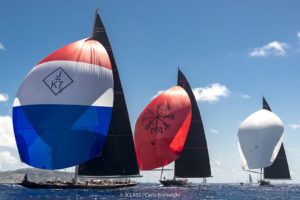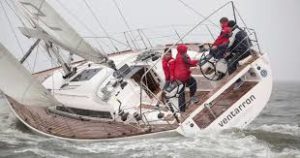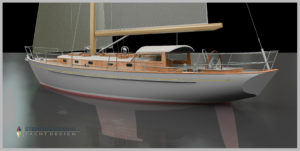
Classic forms, like these J-Class racers, have been heavily explored and immortalized. Via the J Class Association. Photo: Carlo Borlenghi
We’ve been operating in this industry for 30-plus years, and of that time we’ve enjoyed some 20 years in creating Spirit-of-Tradition yachts. This SoT thing is now a thing. And we’re lucky to have been involved on the frontlines since its inception.
But, let’s make something distinctly clear about all design: There’s real-world use of boats, like racing in regattas in the U.S., Caribbean, and Europe. And then there is the design of intent and the creation of ideas, brought together by client and architect. These two points headline two different worlds, and the two worlds won’t always communicate in the same language.
For example, when a regatta has a committee whose purpose is to police the racing fleet into classes and track racing data, yachts simply get placed into divisions based on criteria established by the personality and goals of a given race committee. These goals may — or may not — be based on any widely accepted concept of what constitutes the basis of a yacht’s architecture.
That’s a problem of vernacular.
Learning to Speak SoT.

“White Pearl” could be naval design’s image of contextual architecture. Photo: Wikimedia Commons.
The disconnect between the dialect in which a race committee views a design, and the dialogue around a designer’s work, emphasizes a lack of common language. When looking at design themes, this becomes demonstrated within modern-classic regatta circles and barroom conversations while arguing architectural principles. This vernacular problem has become challenged by the variance in acceptable standards. It’s become difficult for owners, builders and other stakeholders to navigate conflicting vernaculars.
And frankly the confusion is unnecessary. As we pontificate on the lessons we learn from creating yachts, the constructive design philosophy becomes sharpened when analyzing yachts as examples of a well-formed architectural vernacular.
In the world of land-based architecture, we are immediately familiar with design terms like contextualism, brutalism, art deco, post-modern industrial to name a few. These terms label a genre or style of architecture; and most of us dummies can relate to these themes, even as they might convey a much more scholastic nature to the architectural discussion. If we all generally see that the role of an architect and designer is as an engineer, an artist, and a social designer, then it’s important to realize how a common terminology and language help us all enjoy the broader discussion of the results of these designs. The Spirit-of-Tradition is an important part of our lineage, but our design process ultimately reflects the client/designer relationship; we never aim to pigeon-hole into one genre or another until and unless it’s relevant to do so.
The marine industry exhibits a funny lack of formality; look at the cross-section of yachting and yacht marketing today. We can identify different genres, types and styles of yachts. But many of these naming constructs are silly and outright boring. Who the heck was in charge of marketing on the

A racer-cruiser? Who was in the marketing office that day? Photo: Courtesy of Billy Black
day they released the word ‘Express’ and ‘Express Cruiser’ or ‘Cruiser’ and ‘Racer-Cruiser’? Come on, captain obvious, every sailboat is at its essence both a cruiser and a racer at some point during the owners’ use of that boat. Gran Prix, maxi, rule boats, center console, sedan, expedition, sport-fish, etc. Seriously, can we be a little more inventive? Just like contextualism in architecture is reasonably understood, once you have the language and tools down, as with Spirit-of-Tradition, maybe we can find more meaningful terms that fit yachting design elements more truly.
Telling A Vintage Tale.
Identifying and dividing up fleets between the classics and vintage yachts is not complex. Or, conversely we also know exactly what makes a Volvo boat, for example. We know a gentleman’s racing sled when we see it. Each example ‘speaks’ to a genre, just like a ‘runabout’ or a ‘skiff.’ In boats we seem stuck to naming models and types more than we spring to more artful terms. So, as we aim to promote exciting new design of power and sailing craft, an overhaul to more serious design-speak is a valiant goal.

Italmas, to be launched later this summer at Van Dam Custom Boats, fits squarely into the Spirit of Tradition stream-of-conscious debate. Image: SWYD.
Recently, we framed up a tight argument of logic to build a vernacular in Spirit-of-Tradition design cues and elements. We noted examples of SoT designs and the attributes that position a design into the genre. We critiqued our designs, with others, and cast those against our proposed rubric. If we are going to create an idiom, SoT or any other, wouldn’t we all appreciate a mechanism that addresses basic standards that position a design into its vernacular?
Spirit-of-Tradition design, among many genres, is a serious design idiom. Let’s build a case for positioning yacht designs into an organized vernacular world.